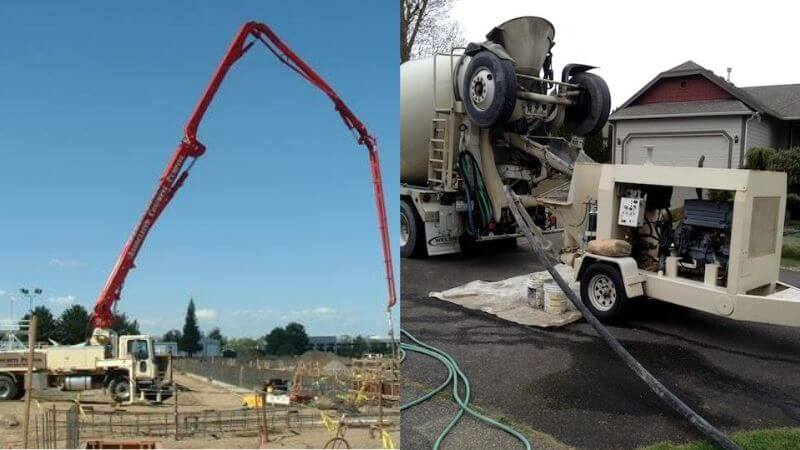Concrete Pump vs Line Pump—Which can really meet the demand of your worksite?
Well, with so many exhaustive specifications, the pumps can highly differentiate the productivity of your work. However, without proper knowledge, choosing either can be a downfall.
Hence, you require proper knowledge in terms of these pumps.
Finally, deciding either of which can really meet the dynamic requirement of your jobs.
Primarily, we were able to distinguish four differences in Concrete Pump Vs Line Pump.
#1: Attachment and Portability
The principal difference between the line pump and boom pump depends on the attachment and mobility they entail. In short, the add-on they hold and who they can be transferred from one location to another.
For instance, a boom pump is fixed to the truck semi-trailer. However, a line pumps mounts onto a truck or a trailer.
Moreover, a boom pump is the sole complete unit and utilizes the robotic arm to perfectly pour concrete.
The pump is easily moveable with the truck. On the other hand, the line pump is more portable and convenient. As it needs just hoses to be manually fixed to the machine’s outlet.
#2: Volume
Basically, a boom pump is capable of bigger construction projects and concrete jobs. The reason is high volumes of concrete production. In fact, the output exceeds 150 cubic yards per hour.
Boom pumps are continuously utilized in medium high rise buildings and large commercial slabs. Depending on the type of line pump and size, their production can be from 20 to 90 cubic yards per hour.
However, line pumps are generally utilized for smaller construction jobs. Also, they can be used for building bond beams, swimming pools, underwater concrete repair, residential slabs, and sidewalks
#3: Reach
Boom pumps can reach high vertical heights, they are generally called for high-rise projects. Usually, these come in three or four sections each reaching around 16 feet into the air.
A small concrete pump with five parts can elevate up to 200 feet in the air. Generally, they remain in the exact position until the complete pour is over.
Small Line booms normally function for horizontal pumping needs. Moreover, the hoses of these units can range anywhere from 20 to 1500 feet.
Actually, the Concrete line pump is perfect for places hard to reach. Moreover, the operator can start pour and stop, if the pump requires to move.
#4: Cost
Concrete Pump Vs Line Pump: the prevalent difference lies in their cost. Comparatively, concrete line pumps have significantly lower cost due to their small size. In fact, the pricing is one-third of what a boom pump costs.
Though there are dissimilarities, the pumps should be used depending on the requirement and size of the construction.
For larger projects, a concrete boom pump is better. Whereas for smaller residential or commercial jobs, a small line pump is enough.
Concrete Pump vs Line Pump: Choosing the Right One!!
So, which pumps fits best for your project requirement?
Get the best Concrete line pump rental services by the top concrete company Canada.
Maple Concrete Pumping, the leading Concrete pumping company, is dedicated to providing the top range of high performing line pumps.
Having 8 years of experience in this industry, we know how to get things right.
We are a one-stop solution for all your pumps and concrete construction demands. Our commitment lies in delivering innovative and quality equipment appropriate for all project types.
From larger commercial construction projects to smaller ones, our outstanding boom and trailer pump maintain brilliant productivity.

Thanks for helping me understand that concrete pumping services are using pumps that would be elevated parts up to 200 feet in the air and will remain in the position until the pour is over. I will share this information with my sister who might hire such a service to have an idea of what will happen. It’s because she wanted to have additional floors for her bungalow home now that she will have a family with her partner soon.